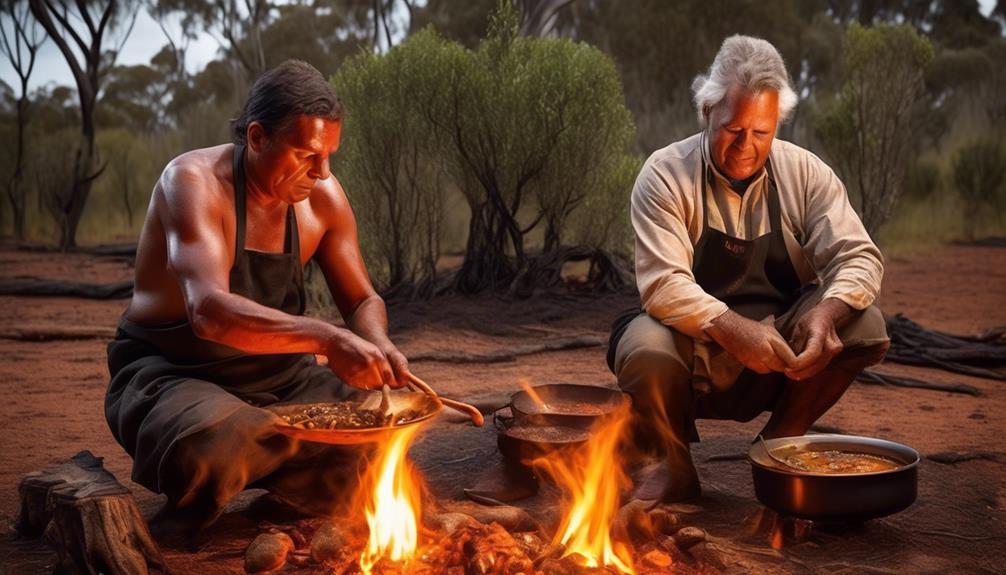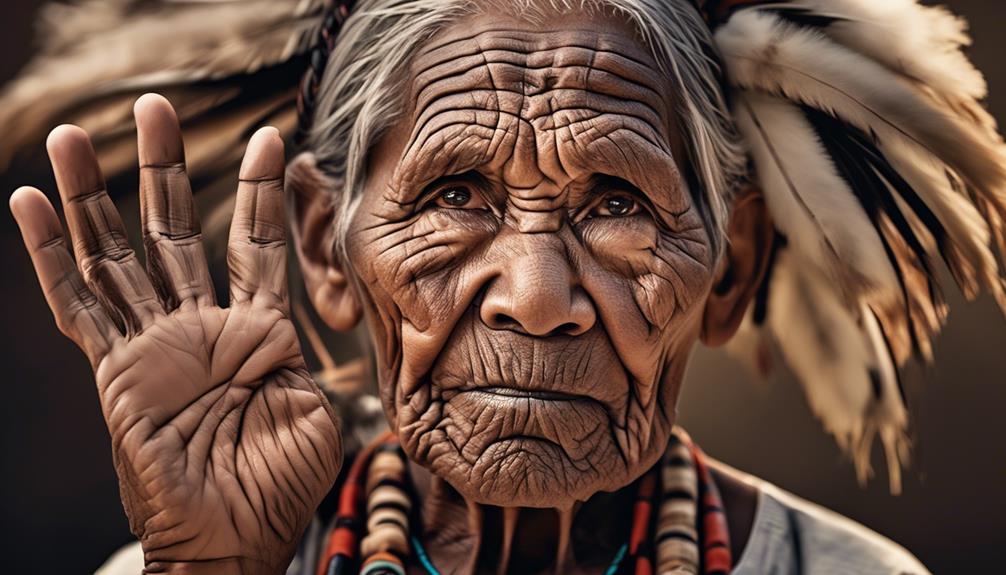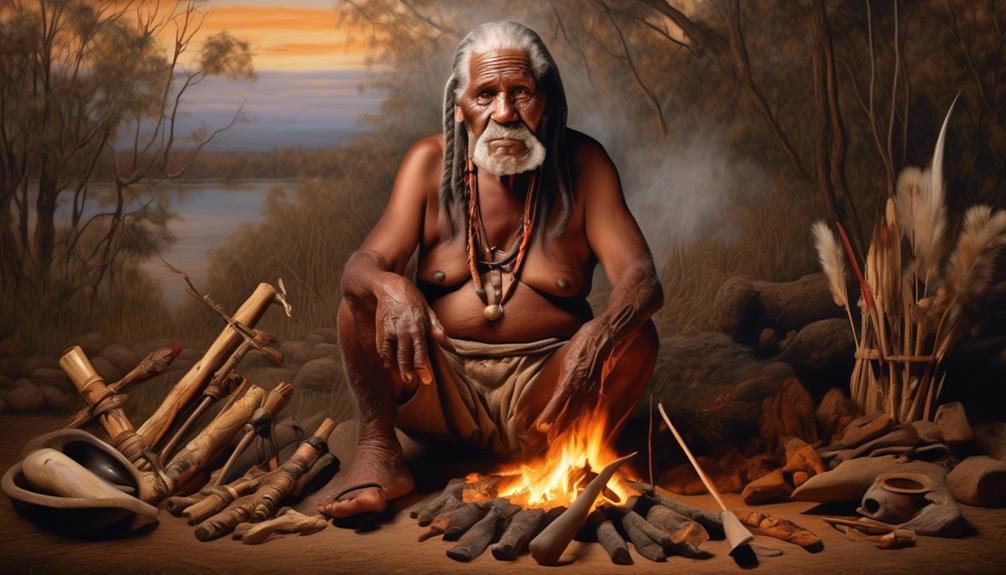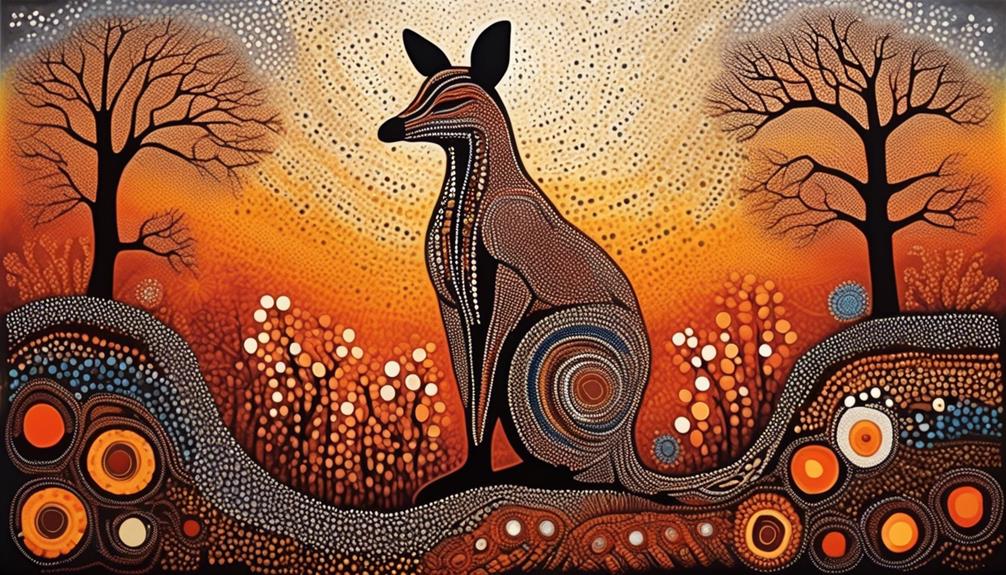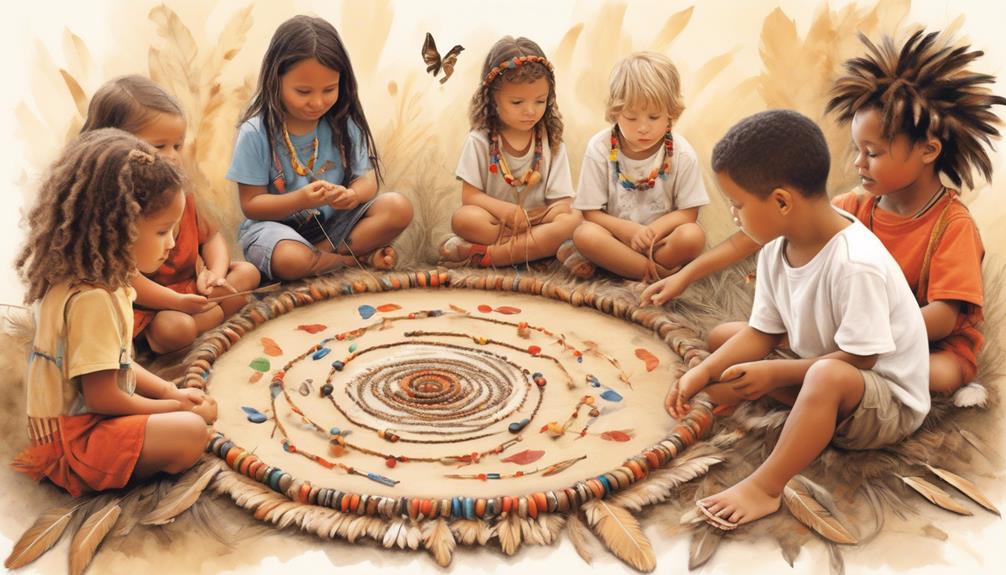Would you like to delve into the rich culinary traditions of Indigenous communities?
From time-honored cooking techniques to the use of unique native ingredients, Aboriginal recipes offer a fascinating glimpse into the cultural and historical significance of food.
As you explore the diverse flavors and stories behind these traditional dishes, you'll gain a deeper understanding of the profound connection between food and Aboriginal culture.
Key Takeaways
- Aboriginal cooking methods such as smoking meat and using earth ovens result in depth of flavor and highlight respect for nature and resource utilization.
- Kangaroo, emu, native fruits, and wattleseed are staple ingredients in Aboriginal cuisine, adding unique flavors and textures.
- Indigenous bush tucker recipes utilize ingredients like finger limes, lemon myrtle, and bush tomatoes to create intense flavors, while smoking and roasting techniques add smokiness and depth.
- Food holds great significance in Aboriginal culture, symbolizing connections to the land, spirituality, and ancestors, and playing a central role in community gatherings and cultural preservation.
Traditional Aboriginal Cooking Methods
Traditional Aboriginal cooking methods involve using natural resources and traditional techniques to prepare and cook food in a way that honors the rich cultural heritage and connection to the land. Smoking meat is a prominent method, where the meat is cured and then slowly exposed to the smoke of certain woods, imparting a unique flavor. This technique not only preserves the meat but also adds depth to its taste.
Another traditional method is the use of earth ovens. These ovens are made by digging a hole in the ground, heating stones in a fire, and then placing the stones in the hole along with the food, which is wrapped in leaves or bark. The earth and the stones effectively act as an oven, cooking the food evenly and imparting a subtle earthy flavor.
Compared to modern cooking methods, traditional Aboriginal techniques often involve more time and effort, but they result in a depth of flavor and a connection to the land that's unmatched. The deliberate process of smoking meat and using earth ovens highlights the deep respect for nature and the desire to utilize its resources thoughtfully.
Mastering these methods requires patience and a deep understanding of the environment, making them not just cooking techniques, but expressions of a profound cultural connection to the land.
Key Ingredients in Aboriginal Cuisine
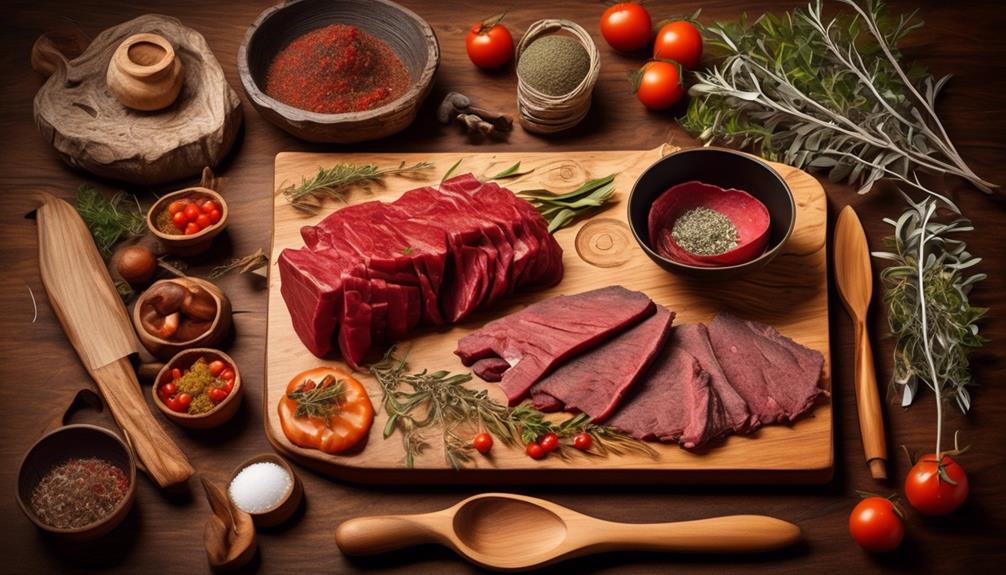
Aboriginal cuisine incorporates a diverse array of key ingredients, each contributing distinct flavors and textures to traditional dishes. One of the most iconic ingredients is the kangaroo, which is lean, low in fat, and rich in protein, making it a staple of many Aboriginal diets. Another essential ingredient is the wattleseed, a versatile seed that adds a nutty, roasted flavor to dishes and is often used in baking or as a spice. Emu, another native animal, is also widely used in Aboriginal cuisine for its rich, gamey taste. Additionally, the use of native fruits such as quandong, bush tomatoes, and finger limes adds a unique tanginess and depth to various dishes.
Traditional cooking techniques play a significant role in the preparation of these key ingredients, with methods such as roasting on open fires, steaming in earth ovens, and smoking meats being deeply rooted in Aboriginal culinary practices. These techniques not only impart distinct flavors but also hold cultural significance, connecting Aboriginal communities to their heritage and land through the act of preparing and sharing traditional meals.
Indigenous Bush Tucker Recipes
Incorporating indigenous bush tucker into your culinary repertoire offers a unique and flavorful experience, rich in tradition and cultural significance. The use of indigenous ingredients and cooking techniques not only adds depth to your dishes but also provides a profound connection to the land and its people.
When exploring indigenous bush tucker recipes, you'll discover a fusion of ancient wisdom and modern gastronomy, creating a culinary experience that's both enlightening and delicious. Here's what you can expect when delving into this world:
- Awe-inspiring Flavors:
- Uncover the intense flavors of indigenous ingredients like finger limes, lemon myrtle, and bush tomatoes, which add a burst of unique taste to your dishes.
- Experience how traditional cooking techniques such as smoking, roasting over open fires, and earth-oven baking infuse a distinct smokiness and depth into the food, elevating the overall flavor profile.
Exploring indigenous bush tucker recipes allows you to honor the traditions of the Aboriginal people while expanding your culinary horizons, making it a truly enriching and enlightening journey.
Significance of Food in Aboriginal Culture
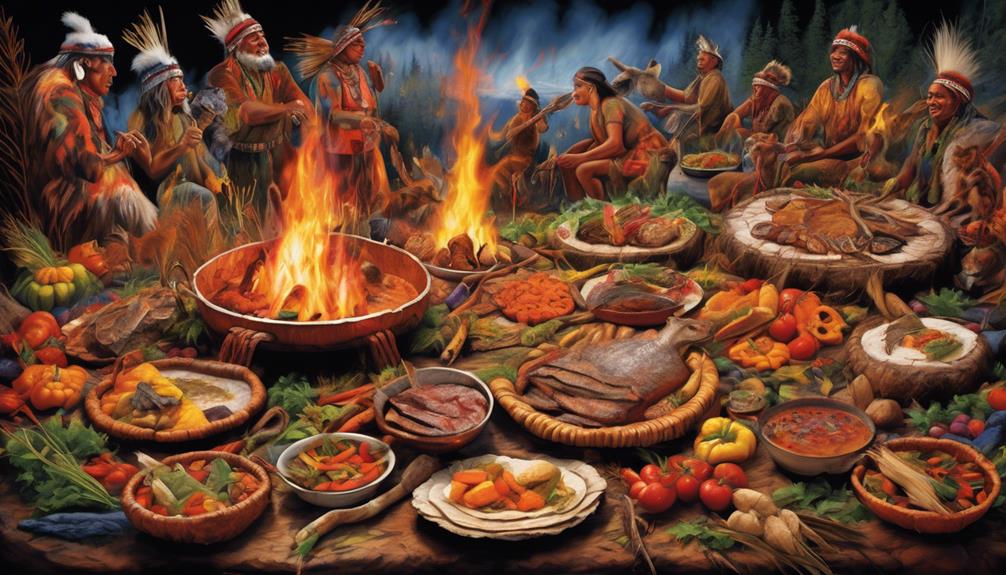
As you explore the significance of food in Aboriginal culture, you'll come to appreciate how the intense flavors and traditional cooking techniques of indigenous bush tucker recipes are deeply intertwined with the cultural heritage and values of the Aboriginal people. Food holds immense cultural symbolism in Aboriginal communities, representing connections to the land, spirituality, and ancestors. Each ingredient used in traditional Aboriginal recipes carries profound meaning, reflecting the deep spiritual and cultural connection to the land and its resources.
Moreover, food plays a central role in community gatherings within Aboriginal culture. These gatherings often revolve around the preparation and sharing of meals, fostering a sense of unity and belonging. The act of coming together to prepare and consume food not only nourishes the body but also nourishes the spirit, strengthening the bonds within the community. In this way, food becomes a vehicle for preserving and passing on cultural traditions, knowledge, and stories from one generation to the next.
The significance of food in Aboriginal culture extends far beyond mere sustenance; it's a living expression of heritage, spirituality, and community.
Modern Interpretations of Aboriginal Dishes
When exploring modern interpretations of Aboriginal dishes, contemporary culinary innovators have skillfully infused traditional ingredients with innovative cooking techniques to create a harmonious blend of heritage and modernity. This cultural fusion has given rise to contemporary twists on classic Aboriginal recipes, offering a delightful experience that connects the past with the present.
Here's how these modern interpretations evoke emotion in the audience:
- Preservation of Tradition: By embracing traditional Aboriginal ingredients and culinary methods, modern interpretations honor the rich cultural heritage and pay homage to the wisdom of Aboriginal ancestors. The resulting dishes evoke a profound sense of respect and appreciation for the roots of Aboriginal cuisine.
- Emotional Impact: The fusion of traditional and modern elements in Aboriginal dishes sparks a deep sense of connection and nostalgia, evoking a profound appreciation for the enduring legacy of Aboriginal culinary traditions.
- Innovative Flair: Through the incorporation of contemporary cooking techniques and presentation styles, these interpretations breathe new life into Aboriginal cuisine, captivating the audience with their creativity and artistry.
Engaging in these modern interpretations offers a platform for both Aboriginal and non-Aboriginal chefs to celebrate the diversity and complexity of Aboriginal culinary traditions while embracing the evolution of food culture.
Frequently Asked Questions
Are There Any Specific Rules or Customs Around Who Can Prepare Traditional Aboriginal Dishes?
In many cultures, certain traditional dishes hold significant cultural importance. When it comes to traditional cooking practices, there are often specific rules or customs about who can prepare these dishes. This varies widely between cultures, and understanding and respecting these customs is a crucial part of preserving cultural traditions.
It's important to recognize the cultural significance of these practices and to approach them with respect and understanding.
Are There Any Important Rituals or Ceremonies Associated With the Preparation and Consumption of Aboriginal Meals?
Important traditional practices, cultural significance, and rituals are associated with the preparation and consumption of aboriginal meals. These rituals often involve showing respect and gratitude for the food, land, and ancestors.
The act of preparing and sharing traditional Aboriginal dishes is a deeply meaningful and communal experience. It's important to honor and understand these customs when engaging with Aboriginal food traditions.
How Have Aboriginal Cooking Methods and Recipes Been Affected by Modernization and Globalization?
The impact of colonialism and globalization on Indigenous cuisine has brought significant changes to traditional cooking techniques and recipes. Cultural appropriation has led to the blending of Indigenous and modern cooking methods, altering the authenticity of Aboriginal dishes.
As a result, there's a need to preserve and protect these traditional recipes and cooking methods to ensure that they continue to be a vital part of Indigenous culture.
What Are Some Lesser-Known or Underappreciated Aboriginal Ingredients That Are Used in Traditional Dishes?
You mightn't realize the wealth of indigenous ingredients that add depth to traditional dishes.
Incorporating sustainable practices to preserve culinary traditions is essential for cultural preservation.
Lesser-known underappreciated Aboriginal ingredients, like bush tomatoes and wattleseed, bring a unique flavor profile and historical significance.
Exploring these ingredients not only expands your culinary repertoire but also honors the rich heritage of Aboriginal cultures.
Are There Any Regional Variations in Aboriginal Cooking and Cuisine That Are Not Commonly Known?
Regional variations in aboriginal cooking are rich and diverse, often tied to cultural significance and traditional techniques.
Ingredient diversity is a key feature, with unique flavors and cooking methods varying from one region to another.
These regional differences showcase the depth of aboriginal culinary traditions, offering a deeper understanding of the diverse cultures and landscapes that have shaped these traditional cuisines.
Conclusion
In conclusion, Aboriginal recipes are deeply rooted in tradition and culture, showcasing the importance of using indigenous ingredients and cooking methods.
For example, a modern interpretation of a traditional Aboriginal dish like kangaroo stew incorporates contemporary cooking techniques while still honoring the heritage and significance of the meal.
By exploring Aboriginal cuisine, we gain a greater appreciation for the rich culinary history and cultural significance of indigenous foods.
Mary is a passionate writer who brings creativity and a fresh perspective to our team. Her words have the power to captivate and inspire, making her an essential contributor to our content. Mary’s commitment to storytelling and dedication to promoting Indigenous culture ensures that her work touches the hearts of our readers. We’re fortunate to have her as part of our team.
